Seeking the complete truth
Editor's note: Meagan Peters is research manager at Chicago-based Solution Partners Consulting. Curt Fedder is managing director at Life Stage Research Insights, Chicago.
The ability to illuminate and subsequently influence consumer perceptions and motivations is the goal of marketing research studies, whether qualitative or quantitative. Attaining unbiased, unfiltered reactions that uncover consumers’ true emotional responses is challenging, whether soliciting responses to marketing materials (ads, concepts or positioning statements) or simply trying to understand consumer attitudes and behavior.
Currently, in the marketing research community, there is a great deal of interest in the application of various psychological theories to get to the heart of consumer response. One emerging technique is emotions research, with facial coding and body language analysis representing some of the leading methods for capturing emotions. The purpose of this article is to review the theory and practice of emotions research and provide examples of how the approach can be applied in qualitative research to identify true, unfiltered emotions and insights, leading to implications that can only be uncovered through the use of emotions research.
Skilled researchers, particularly qualitative researchers, are highly adept at delving into consumer perceptions and motivations through a variety of interviewing and analysis techniques, including open-ended questioning, projective techniques, laddering, etc. While these techniques go a long way in eliciting consumer response, they rely on consumers’ ability to articulate their own thoughts. Whereas emotions research, facial coding and body language analysis facilitate unfiltered access to consumer feelings and perceptions.
Extensive research has demonstrated that emotions are how people form their attitudes, beliefs and opinions – the basis for their judgments, decisions and behaviors. The old adage “Think with your head, not with your heart” is no longer relevant or even factual because it is virtually impossible to make decisions that are devoid of emotions. Emotions are the lenses by which people process information and react to stimuli; we are always “feeling” or experiencing emotion.
Emotions are core to consumer behavior and thus it is incumbent upon marketers to understand consumers’ true emotional response. Emotions are the primary reason consumers prefer one brand over another. Further, positive emotions toward a brand have an impact on brand loyalty. And, while people typically provide a logical argument to rationalize a purchase decision, their emotional response is often what drives the purchase in the first place.
Emotions are both conscious and unconscious. Thus, a methodology that captures unconscious emotions expressed through nonverbal behavior is a critical and insightful tool for marketers. Facial coding and body language analysis reveal how people “leak” their true emotions through expressions and movements, even when trying to be deceptive. People often try to regulate themselves but this type of coding takes that into account because emotions manifest themselves in physical, involuntary ways. Further, body language accounts for 50 percent-70 percent of communication.
Powerful, measurable points of data
Emotions are powerful, measurable points of data which complement and triangulate other information that is collected about consumers. Using a science-driven approach that relies on observable data provides richer, deeper insights to better understand consumers.
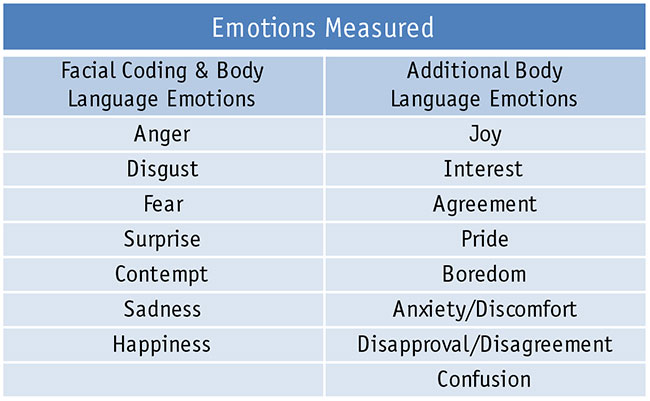
In this scenario, functional analysis is applied to consumers’ nonverbal behavior. It relies on interpreting complex nonverbal behaviors that are automatic, involuntary and often stereotyped. Facial movements are coded based on the well-tested and renowned research of Paul Ekman. Body language is analyzed based on the scientific research from researchers such as Wallbott and Friesen. These coding systems are then applied and interpreted to identify what emotions a person is experiencing in response to stimulus material or open-ended questioning.
To demonstrate the application and benefits of this approach, two illustrative studies were conducted, one in which the approach was deployed to test consumer response to a print ad and the other to gain deeper insights into attitudes and behavior. Both studies illustrate how adding facial coding and body language emotion analysis to a typical qualitative research study provides deeper insights that go beyond findings based on consumers’ conscious (or stated) responses, uncovering new dimensions to the findings or confirming them. This results in deeper insights into consumers, yielding more powerful conclusions and strategies that help companies be successful in the marketplace.
In-depth qualitative interviews were conducted and video-recorded. The camera was focused on the respondent’s body and face to facilitate recording of their facial expressions and body mannerisms.
The videotape was then analyzed using custom coding techniques based on study objectives and using the scientific framework previously described. Thus, the stimulus materials or reported attitudes and behavior are evaluated against a comprehensive set of emotional characteristics. Reporting merges traditional qualitative findings with emotion analysis to provide a rich understanding of consumer responses through a cohesive story.
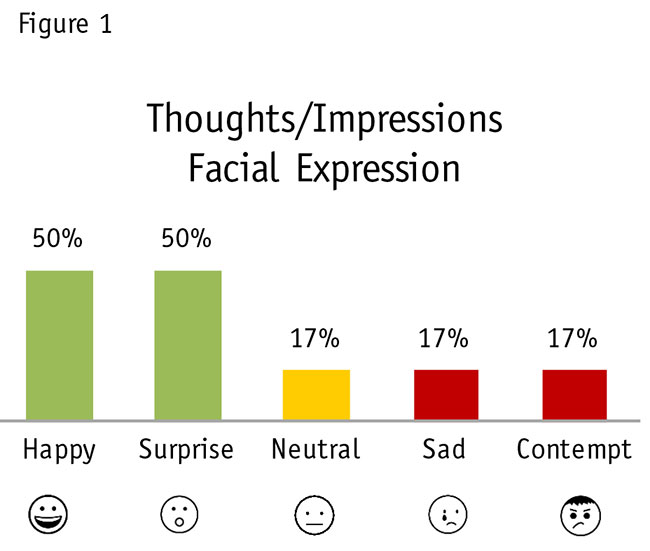
Emotions research applied to an advertising study
In this first example, travelers were interviewed to assess their emotional response to a print ad for a hotel chain. Through typical qualitative discussion it was learned that that consumers had generally positive responses to the ad. The ad strongly communicated that the hotel chain is a place to go to relax, enjoy a spa weekend, be with your spouse and perhaps share a romantic weekend. Facial expressions were consistent with what respondents reported verbally, confirming most were happy or surprised (Figure 1). Body language suggested interest (Figure 2). The brand seemingly has the opportunity to create affinity with its audience.
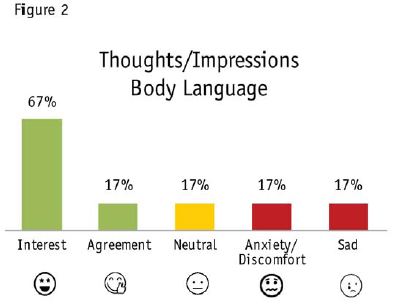
But one notable respondent, a single female who potentially reflects a sizeable segment for the hotel chain, displayed emotions of sadness, anxiety/discomfort and neutrality, even though she had not verbally expressed these feelings. Use of a polarizing tagline about a couple’s retreat resulted in these negative emotions. For most consumers this implied a getaway from work, family and other stresses. However, this respondent pointed out verbally that this statement excluded her because she is currently single. Based solely on what she said, this did not appear to be a major concern. However, facial coding indicated that the depth of her negative emotional response was much greater than she was able to verbalize or perhaps even know herself. More importantly, the depth of emotional response was observed only through emotions coding.
Negative emotions like these have the potential to create dissonance between consumers and brands. Based on this finding, the research recommended revising this statement. Without the emotions coding, no changes would have been suggested.
Emotions research applied to an attitude-and-usage study
In the second example, a study among Millennials was conducted to assess emotional reactions to their current financial situation and spending habits. Overall, the study revealed that while Millennials experience an underlying sense of anxiety relating to their finances, they are positive when it comes to spending money to enjoy life and pursue their dreams. This represents a state called emotional ambivalence where one simultaneously experiences two different emotions from two dimensions (positive and negative). This results in unique decision-making outcomes.
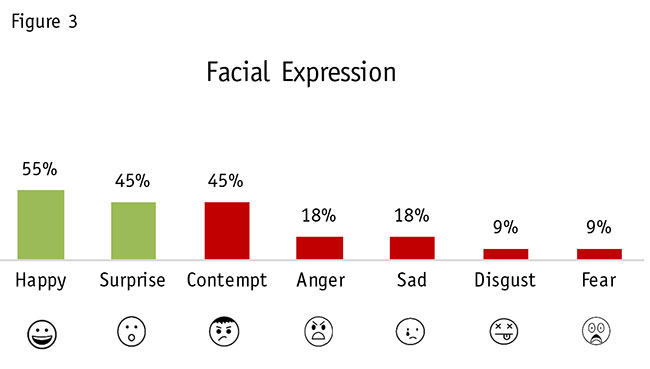
More specifically, when questioned about what they would do with extra spending money, Millennials experience anxiety/conflict/ambivalence that becomes apparent only through monitoring facial expressions and body language. Facial expressions reveal both positive and negative emotions – surprise, happiness and contempt (Figure 3). The positive emotions reflect the pleasure Millennials gain from spending their money on indulgent or lifestyle-oriented purchases. But the negative emotions revealed, particularly in their body language (Figure 4), reflect Millennials also knowing in the back of their minds that they should be practical and more disciplined with spending on non-necessities such as eating out or travel.
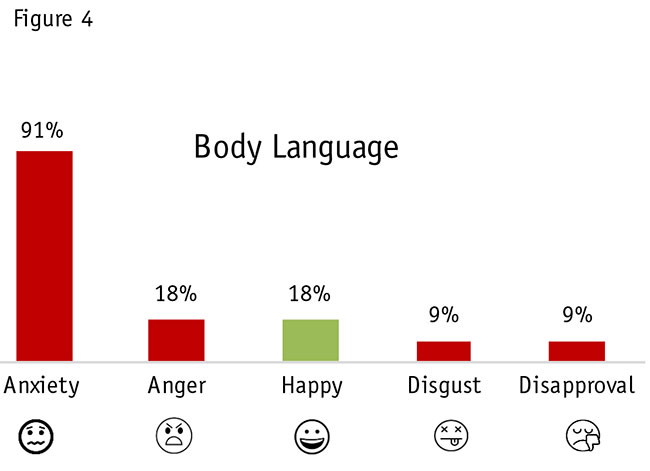
There are important implications resulting from this learning. The array of positive and negative emotions Millennials experience represents a unique set of challenges for marketers. This is because these mixed or ambivalent emotions lead to a high degree of uncertainty which, in turn, influences their unpredictable and often inconsistent usage of products and services vs. prior generations. Ambivalence also leads to more creativity, suggesting that Millennials will seek or be more receptive to non-traditional ideas and offerings (e.g., apps offering financial advice).
Thus, marketing communications need to reflect the tone and texture that will resonate with Millennials’ emotions by appealing to their aspirational side while at the same time addressing their concerns and apprehensions. Anxiety-reduction will be critical to success. Communication materials should attempt to combine the product message or brand promise with solutions and reassurances to help Millennials feel more secure and reduce uncertainty in their lives.
Insights that go beyond
Emotions research is a powerful tool. Understanding the emotional state of your target audience can help unlock their decision-making process. Applied to qualitative research, it can provide deep, richer insights that go beyond what might be learned in a typical qualitative research study.
